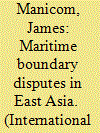| Srl | Item |
| 1 |
ID:
151995


|
|
|
|
|
| Summary/Abstract |
This article analyses two security challenges facing the Royal Cambodian Government (RGC) and the Cambodian Defence Organization at the strategic level for the next decade. The first obvious challenge relates to the stalemated territorial dispute along the Cambodia–Thailand border, particularly the question of ownership of the Preah Vihear (called PhraViharn in Thailand) temple and its surrounding area since October 2008. Bilateral talks to manage the crisis and dispute failed, and the same happened to mediation and peacekeeping efforts by the Association of Southeast Asian Nations (ASEAN) in general and Indonesia in particular. This is considered to be a top security challenge for Cambodia’s national security and drives the military forces’ capability adjustment. The second challenge arises from the overlapping maritime boundary dispute with Thailand in an area which is believed to contain significant oil and natural gas reserves. The article will focus on the nature of the current border conflict with Thailand and its implications for the Cambodian Defence Organization given its limited budget and capability. This article argues that these two key security factors have significantly underpinned Cambodia’s strategic environment and have greatly impacted upon and shaped Cambodia’s reform agenda, defence posture and international engagements. It is also argued the conflict severely tested the regional organization ASEAN and Indonesia as its Chair.
|
|
|
|
|
|
|
|
|
|
|
|
|
|
|
|
| 2 |
ID:
106358


|
|
|
|
|
| Publication |
2011.
|
| Summary/Abstract |
The impact of climate change on the circumpolar north has raised the profile of the Arctic Ocean to coastal states and presents serious foreign policy challenges. Chief among these is the pending delimitation dispute over the extended continental shelf between Canada, Denmark, the United States, and Russia. While delimitation disputes are not new to Arctic states, extended continental shelf claims are complicated by the existence of multiple claimants and a still developing international legal regime. To inform policymakers about what to expect from overlapping claims to disputed maritime areas, this paper draws comparative lessons for Arctic policymakers based on East Asia's experience responding to overlapping jurisdictional entitlements created by the UN Convention on the Law of the Sea (UNCLOS). East Asian states have been grappling with the challenge presented by overlapping claims to resource-rich seabeds since the region ratified UNCLOS in the mid-late 1990s. In light of similar geographic conditions (a dispute over a semi-enclosed sea), alliance structures and the relative infancy of the claimant states with UNCLOS entitlements-Canada only ratified the treaty in 2003, and the United States has yet to do so-this paper sets out the case that important comparative lessons can be drawn from the East Asian experience with maritime delimitation disputes.
|
|
|
|
|
|
|
|
|
|
|
|
|
|
|
|